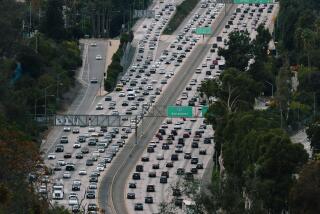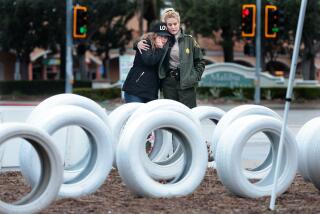Faulty Truck Brakes Blamed in Freak Fatal Crash, CHP Says
- Share via
THOUSAND OAKS — Monday’s fatal big-rig crash on the Conejo Grade is the kind of accident that haunts many Ventura County drivers.
California Highway Patrol officials believe that faulty brakes on an 18-wheeler led to the crash that killed 45-year-old Ismael Val Chaidez of Moorpark. They are calling it a freak accident and say trucks generally pose no special risks on the grade.
But for drivers like Roberta Vargas, a Thousand Oaks resident who navigates the 1.5-mile downhill chute four times a week, any trip on that stretch of the Ventura Freeway is a life-threatening experience.
“If you go too fast, the hair just flies off the back of your head, it’s so scary,” said Vargas, a 63-year-old retiree. “But if you go too slow and you get caught between two big trucks, it can be just as scary.
“I always say, ‘Thank God, I made it,’ when I get to the bottom,” she said.
Chaidez, who owned The Magic Mop cleaning service in Moorpark, was leaving the freeway at Camarillo Springs Road when a runaway flatbed truck driven by 30-year-old James Greene rammed him, said Dave Cockrill of the California Highway Patrol.
Greene, a Simi Valley resident who works for U Rent Inc., a Camarillo trucking company, told investigators that he lost his brakes at the top of the grade. He tried everything from scraping against the guardrail to swerving back and forth to reduce his speed, Cockrill said.
The semi was going 60 to 65 mph when it struck Chaidez’s Ford pickup, witnesses told police. Greene’s speed prior to losing his brakes is not considered a factor in the crash, according to Cockrill.
“As of now, it looks like the brakes just failed” and Greene will not be cited, Cockrill said.
The Conejo Grade scales--both north and south--were closed Monday for the Presidents Day holiday, which meant that Greene’s big rig missed an inspection that might have detected the failed brakes before he headed down the hill.
Greene, who suffered cuts and bruises in the crash, was treated and released from a local hospital the same day.
Investigators will look at inspection records this week to determine if the tractor-trailer was properly maintained.
They will find nothing out of the ordinary, said Bob Arbon, U Rent president.
“That truck was properly maintained,” Arbon said Tuesday. He would neither discuss details of the accident nor talk about the inspection record for Greene’s truck.
“It’s a hard time for us,” Arbon said. “We haven’t had anything like this happen in 35 years. You hope something like this never happens.”
Chaidez’s wife, Victoria, said her 5- and 7-year-old children, along with numerous friends, are coping with the tragedy.
“People here are very, very devastated,” she said.
Ismael Chaidez was involved in the Simi and Moorpark chambers of commerce, and the El Concilio organization that promotes opportunities for area Hispanic youth, Victoria Chaidez said.
“He’ll be remembered as a generous person who tried to help others,” she said.
Big-rig accidents are a rarity on the Conejo Grade, one of the state’s steepest highway segments. Its slope of 7% is second only to the Cuesta Grade, a 2.4-mile stretch of U. S. 101 in San Luis Obispo County, according to officials with the California Department of Transportation.
In fact, the last major accident on the Conejo Grade was in October, when a small truck carrying gravel overturned in the northbound lanes, causing a 10-mile backup. That crash caused two related fender-benders. No one was injured.
CHP Officer Sherie Latimer, who works at the scales, said she has heard no talk of building a ramp for runaway trucks--common in mountainous areas--at the bottom of the grade. “I don’t recall it ever being an issue,” she said.
Still, many drivers worry about trucks barreling down the hill.
Of particular concern to Vargas is the task drivers face of merging with northbound trucks leaving the Conejo Grade inspection station.
“I wish they would make a special lane all the way down for those trucks,” she said.
Mar Vista resident Howard Pore, who commutes two hours every day to Oxnard, worries about speeding truckers on the Conejo Grade.
“It’s a death trap up there,” he said. “They see those signs that say ‘Watch your downhill speed,’ but they don’t pay any attention to it. They’re just going hell-bent-for-leather down that hill.”
But the CHP’s Cockrill disagrees.
“Cars are, by far, the biggest offenders for speeding on the grade,” he said. “Trucks do their fair share, and we try to enforce the 55-mph truck speed limit as much as we can, but fast cars outnumber speeding trucks any day.”
The speed limit for cars on the grade is 65 mph, and it is ritually ignored by drivers headed up and down the hill, Cockrill said.
Most trucks are in their lowest gears as they travel down to Camarillo and can’t gain much speed after stopping at the northbound inspection station, he said.
Trucker Danny Sendejaz of Oxnard said big rigs are not to blame for risks on the grade.
“It’s those drivers who cut in front of us and expect us to stop on a dime,” he said. “I always have that problem.”
Horst Liebel, a Newbury Park resident who commutes to Camarillo each day, agreed that truckers are generally not the problem. It’s the slower drivers he worries about.
“They go down at 45 mph because they don’t know how to drive in fast traffic,” the 46-year-old said. “I’m from Germany, where people driving 120 mph on the Autobahn cause less than 2% of the accidents. I think people should be driving faster around here.”
When speed is not a factor in a big-rig crash, maintenance can be.
When it comes to highway truck inspections--which can catch everything from worn-out air-brake lines to broken brake drums--California leads the country in the number performed each year, said CHP Sgt. Kent Kilgore, who works at the Conejo Grade truck scales.
More than 1 million trucks passed through the stations last year, Kilgore said. About 16,000 were pulled aside for inspections, with 5,400 put “out of service,” where they could not leave the site until their rigs were fixed, he said.
“Our inspections in this state equal the total number of every other state combined,” Kilgore said. “We head off most of the mechanical problems.”
When an accident occurs, people point fingers, but Kilgore said some common sense would be a good rule of thumb for any driver taking the grade, whether they are in a Peterbilt or a Peugeot.
“There’s usually no problem for anyone if they watch their speed,” he said. “It’s that simple.”
More to Read
Sign up for Essential California
The most important California stories and recommendations in your inbox every morning.
You may occasionally receive promotional content from the Los Angeles Times.













